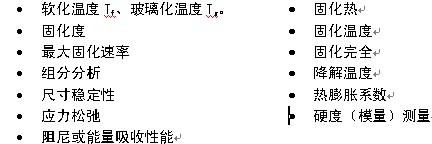The so-called thermal analysis technology is a set of technologies that characterize the relationship between material properties and temperature. It has extensive applications in qualitative and quantitative characterization of thermal properties, physical properties, mechanical properties, and stability of materials, as well as the research, development and production of materials. Quality control in China has very important practical significance.
At present, thermal analysis technology has become an indispensable and important method in the research and development and quality control of electronic materials. Thermal analysis technology can provide tests for the following properties of electronic materials:

Taking the printed circuit board as an example, this paper presents in detail the different thermal analysis techniques and the possibility of comprehensive evaluation of material properties from different angles.
introduction
A printed circuit board (PCB) is a substrate board that is used to carry circuits for printing electronic components. It is usually formed by pressing glass fibers and copper foil with a resin as a binder. The actual use requirements for printed circuit boards are as follows:
Suitable structure hardness and dimensional accuracy.
Lower thermal expansion (influence of solder, operating temperature). Since the PCB is anisotropic, the coefficients of thermal expansion in different directions (length, width, thickness) are different.
High enough softening temperature, because when the resin softens, the mechanical properties and dielectric properties of the entire PCB will shift greatly. Due to the operation of the solder and the heat accumulation during the actual use, the resin is easily degraded, and this degradation is often accompanied by the escape of gas to cause delamination of the entire PCB, thereby damaging the structure of the PCB.
Flame retardant properties. The high performance FR4 standard board has good flame retardant properties.

Laboratory equipment
METTLER-TOLEDEO STARe Thermal Analysis System;
Differential scanning calorimeter DSC822e (with autosampler and air cooling unit);
Thermo-mechanical-diffusion instrument TMA/SDTA840;
The thermogravimetry-diffusion heat analyzer TGA/SDTA851eLF1100°C was used for gas product analysis in some test experiments with a Balzers ThermaStar or Matson Genius II.
DSC measurement
The DSC (differential scanning calorimetry) technique is used to measure any change in heat flow associated with material transmutation. As listed in the table, the DSC technique is mainly used to determine the glass transition temperature of the PCB and the degree of cure of the resin used in the PCB.
If in the second DSC scan, the transition point of the glass transition temperature is greatly increased, this indicates that the curing reaction of the resin in the PCB is not complete; the PCB is likely to absorb moisture or solvents from the environment during long-term storage. The effect of the formation of the relaxation effect of helium, these effects will be reflected in the first scan of the DSC (see Figure 1).

Figure 1 DSC spectrum of FR4 (heating rate: 10K/min): The first measurement scan shows that there is an endothermic effect near 90°C. This is due to the volatilization of water in FR4 with a moisture content of 0.01%; In the second scan, no similar endothermic peak was observed and the glass transition temperature increased from 129.3°C for the first scan to 130.8°C for the second scan.
In addition, the specific heat Cp of the PCB can also be determined by the DSC curve. The Cp value of FR4 increased from 0.89 J/gk at 100°C to 1.05 J/gk at 140°C, and the typical specific heat value of pure epoxy resin was 0.35 J/gk.
Pvc Trims,Bathroom Pvc Trim,Pvc Ceiling Trim,Pvc Chrome Corner
ZHEJIANG DEQING GONAT FENCE CO.,LTD , https://www.gonatpvcfence.com
![<?echo $_SERVER['SERVER_NAME'];?>](/template/twentyseventeen/skin/images/header.jpg)